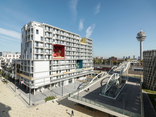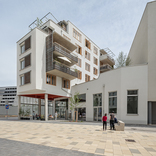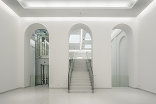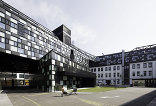Bauwerk
Wohnen und Remise Ottakring
Ernst Michael Kopper, Croce & Klug - Wien (A) - 2000
18. Januar 2001 - Az W
The existing Ottakring tram depot was not only integrated into the new structure’s mixed-used configuration of living and traffic, but lay at the core of its design. 270 union-subsidized apartment units were combined with the new tram depot, its shipping rooms and workshops. The transparent glass façade of the long arcade unit on Maroltinger Street echoes the light construction of the former tram depot building. The façade art project, „signal,“ is emblematic of the entire structure and makes it into a kind of landmark.
In terms of urban planning, the new tram depot mediates between the district of Ottakring’s block construction and the Wilhelminen Hill. The slanting façades facing Joachimsthaler Square mirror the axis of Flötzer Street. Three-story maisonettes are concealed behind the semi-cylindrical projections of the façade. The third floors of these „city cottages“ were constructed as roof terraces, integrated into the façade through their glassed-in sides and open at the top.
The roof of the tram depot functions as a green interior courtyard for the flanking apartment buildings. Accessible via a stairway from Joachimsthaler Square, the roof garden is also connected via ramps to the premises of Wilhelminen Hospital.
To the north, a new street separates the E-shaped apartment building from the rest of the structure and creates a further unusual division of the block.
In terms of urban planning, the new tram depot mediates between the district of Ottakring’s block construction and the Wilhelminen Hill. The slanting façades facing Joachimsthaler Square mirror the axis of Flötzer Street. Three-story maisonettes are concealed behind the semi-cylindrical projections of the façade. The third floors of these „city cottages“ were constructed as roof terraces, integrated into the façade through their glassed-in sides and open at the top.
The roof of the tram depot functions as a green interior courtyard for the flanking apartment buildings. Accessible via a stairway from Joachimsthaler Square, the roof garden is also connected via ramps to the premises of Wilhelminen Hospital.
To the north, a new street separates the E-shaped apartment building from the rest of the structure and creates a further unusual division of the block.
Für den Beitrag verantwortlich: Architekturzentrum Wien
Ansprechpartner:in für diese Seite: Maria Welzig
Akteure
ArchitekturBauherrschaft
Tragwerksplanung











